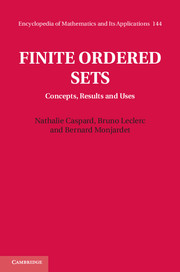Book contents
- Frontmatter
- Contents
- Preface
- 1 Concepts and examples
- 2 Particular classes of ordered sets
- 3 Morphisms of ordered sets
- 4 Chains and antichains
- 5 Ordered sets and distributive lattices
- 6 Order codings and dimensions
- 7 Some uses
- A About algorithmic complexity
- B The 58 types of connected ordered sets of size at most 5
- C The numbers of ordered sets and of types of ordered sets
- D Documentation marks
- References
- List of symbols
- Index
1 - Concepts and examples
Published online by Cambridge University Press: 05 February 2012
- Frontmatter
- Contents
- Preface
- 1 Concepts and examples
- 2 Particular classes of ordered sets
- 3 Morphisms of ordered sets
- 4 Chains and antichains
- 5 Ordered sets and distributive lattices
- 6 Order codings and dimensions
- 7 Some uses
- A About algorithmic complexity
- B The 58 types of connected ordered sets of size at most 5
- C The numbers of ordered sets and of types of ordered sets
- D Documentation marks
- References
- List of symbols
- Index
Summary
This first chapter covers all basic notions of the theory of finite ordered sets and gives an idea of the various domains in which they are encountered. Beware! It would be fastidious and unproductive to approach this book with a linear reading of this chapter. The reader is invited to use it as a reference text in which he will find the definitions and illustrations of the notions used in the next chapters. In particular, we do not provide in this chapter the proofs of the few stated results (the reader will find these proofs in other chapters and/or in exercises). In Section 1.1 we give the concepts and the vocabulary allowing us to define, represent, and describe an ordered set. We also introduce several graphs (comparability, incomparability, covering, neighborhood graphs) associated with an ordered set. Section 1.2 presents some examples of ordered sets that appear in various disciplinary fields from mathematics themselves to social sciences and ranging from biology to computer science. We define the notions of an ordered subset, a chain, an antichain, and of an extension of an ordered set in Section 1.3 and the notions of a join and a meet, of irreducible elements, and of downsets or upsets in Section 1.4. Finally, Section 1.5 describes the basic construction rules (linear sum, disjoint union, substitution, direct product, etc.) that form new ordered sets from given ones.
Ordered sets
In the very beginning there was the order…or the strict order! This section therefore begins with the definition of these two order notions, with their associated terminology.
- Type
- Chapter
- Information
- Finite Ordered SetsConcepts, Results and Uses, pp. 1 - 41Publisher: Cambridge University PressPrint publication year: 2012



